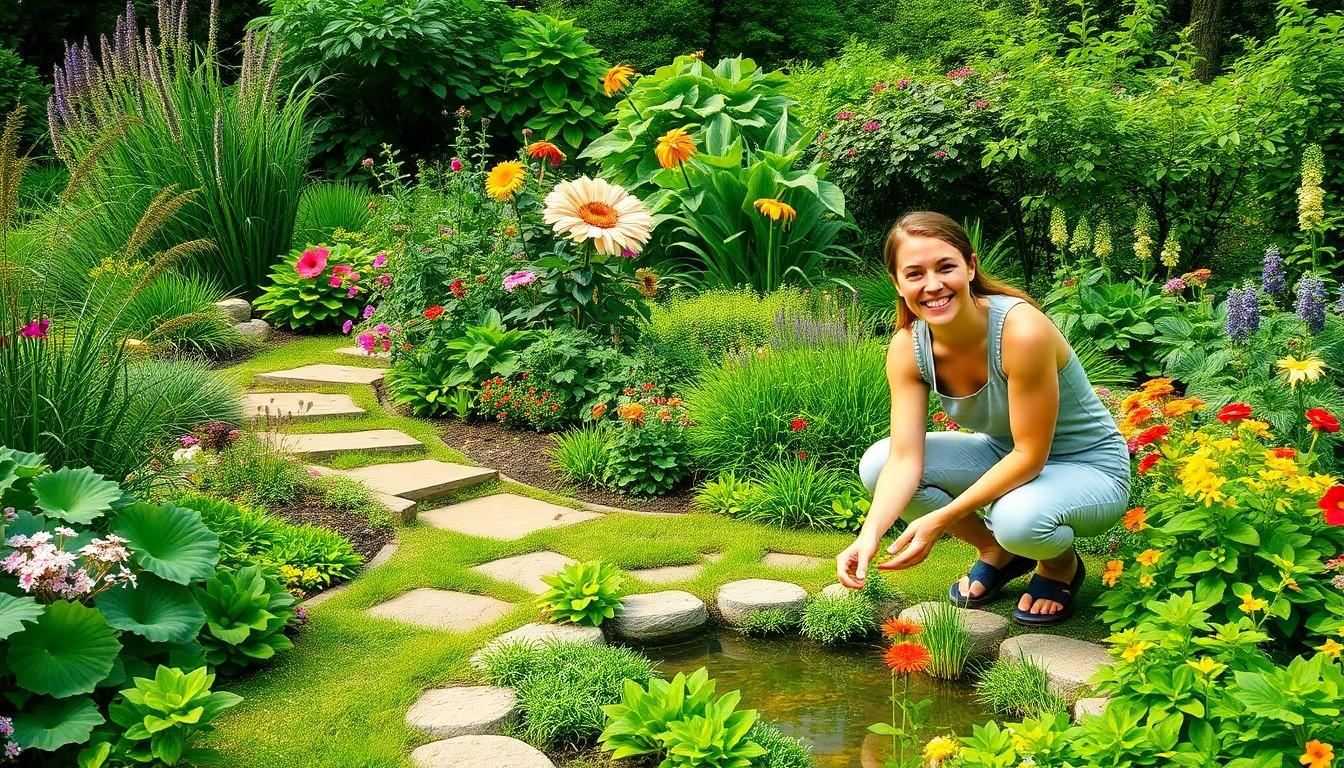Phone:
(701)814-6992
Physical address:
6296 Donnelly Plaza
Ratkeville, Bahamas.

Imagine transforming your yard into a lush paradise where Mother Nature herself would feel right at home. Natural green landscaping isn’t just about pretty plants; it’s a sustainable lifestyle choice that benefits both the environment and your sanity. Who wouldn’t want to sip a cold drink while basking in the glory of a vibrant garden that practically sings with life?
Natural green landscaping integrates various elements designed to enhance both ecological balance and personal health. This landscaping technique promotes the use of native plants, which thrive in local conditions and require less water and maintenance. By prioritizing biodiversity, it creates habitats for wildlife while simultaneously reducing the need for chemical fertilizers and pesticides.
Aesthetically pleasing designs often incorporate features like rain gardens and permeable paving. Rain gardens capture and filter stormwater, helping to recharge groundwater and prevent runoff. Permeable surfaces allow water to seep through, minimizing erosion and supporting local plants.
Encouraging the growth of edible gardens contributes to sustainable living as well. Homeowners appreciate the benefits of growing their own fruits and vegetables, which reduces grocery costs and promotes healthier eating habits. Such gardens not only provide fresh produce but also offer educational opportunities for families about ecology and food systems.
Natural green landscaping also emphasizes the importance of soil health. Organic matter, such as compost, promotes nutrient retention and fosters a thriving ecosystem. This approach minimizes environmental impact while enhancing the overall beauty of outdoor spaces.
Implementing natural green landscaping practices contributes to the well-being of communities. Vibrant gardens improve air quality and provide spaces for relaxation and recreation. These benefits create an inviting atmosphere that encourages outdoor activity, connecting individuals with nature.
This method of landscaping emphasizes sustainability while creating visually appealing environments. By adopting these practices, individuals can enjoy both aesthetic pleasure and the peace of mind that comes from contributing positively to their surroundings.

Natural green landscaping offers significant advantages for both the environment and personal well-being. It incorporates sustainable practices that create thriving ecosystems.
Natural green landscaping contributes positively to ecological balance. Using native plants promotes biodiversity, as these plants attract local wildlife and minimize the need for synthetic fertilizers and pesticides. Rain gardens effectively manage stormwater, reducing runoff and erosion. Studies show that green spaces improve air quality by filtering pollutants. Natural landscapes also enhance soil health by increasing organic matter, which retains nutrients and supports diverse microorganisms. Durable practices like mulching and composting further enhance the environment by promoting sustainable waste management.
Natural green landscaping creates visually striking environments that engage the senses. Vibrant colors from diverse plant species provide year-round beauty. Thoughtful design features, such as curved pathways and natural stones, enrich the landscape’s charm. Edible gardens bring a unique touch, offering both beauty and fresh produce. Seasonal changes introduce new textures and splashes of color, inviting interaction and exploration. Landscaping that embraces nature draws individuals outdoors, encouraging relaxation and connection with the environment. Each element contributes to a harmonious outdoor space that not only captivates the eye but also supports overall well-being.
Implementing natural green landscaping involves several key techniques that enhance sustainability and beauty.
Selecting native plants establishes a foundation for successful green landscaping. Native species adapt easily to local conditions, requiring less water and maintenance. They attract pollinators, supporting biodiversity by creating habitats for birds and beneficial insects. Consider local nurseries for sourcing these plants, as they often provide a variety with proven resilience. Incorporating a mix of perennials and annuals ensures year-round interest and color in the landscape. Additionally, installing ground covers can reduce weeds and prevent soil erosion, maintaining a healthy ecosystem.
Water conservation strategies play a crucial role in sustainable landscaping. Implementing drip irrigation systems delivers water directly to plant roots, minimizing waste. Rain barrels collect stormwater for landscape use, reducing dependency on municipal water supply. Mulching around plants conserves soil moisture while suppressing weeds, leading to healthier gardens. Creating bioswales effectively manages runoff, directing excess water to where it’s beneficial. Utilizing xeriscaping techniques prioritizes drought-tolerant plants, further decreasing water consumption. Together, these strategies foster a sustainable environment that thrives even in arid conditions.
Natural green landscaping presents various challenges that require careful consideration and planning. Understanding these challenges is key to achieving a sustainable design.
Manual interventions often remain necessary to promote the health of native plants. Routine watering during establishment stages helps plants adapt to their environment. Pruning ensures that plants maintain their shapes and promotes healthy growth. Weeds can compete with desired plants for resources, necessitating regular monitoring. Mulching plays a vital role in moisture retention and weed suppression. Over time, some plants may need to be replaced or relocated based on growth patterns or evolving site conditions. A commitment to ongoing care fosters a thriving landscape.
Climate variability poses significant challenges for natural green landscaping. Many native plants thrive in specific conditions, which may fluctuate over the years. Droughts can lead to increased stress on both plants and soil, making effective water management critical. Seasonal changes also influence plant performance, affecting flowering and growth cycles. Utilizing hardy species ensures resilience in changing climates. Observing local weather patterns helps inform future landscaping decisions, promoting long-term sustainability. Adaptation to these climate challenges can enhance the landscape’s overall health and effectiveness.
Natural green landscaping offers a harmonious blend of beauty and sustainability. By embracing native plants and eco-friendly practices, individuals can create vibrant spaces that not only enhance their surroundings but also support local ecosystems. These landscapes invite wildlife and promote biodiversity while reducing reliance on chemical inputs.
The thoughtful design of features like rain gardens and edible gardens further enriches the outdoor experience, providing both aesthetic pleasure and practical benefits. With ongoing care and adaptation to environmental changes, natural green landscaping stands as a testament to the possibility of living in harmony with nature. It’s a rewarding journey that nurtures both the land and the well-being of those who inhabit it.